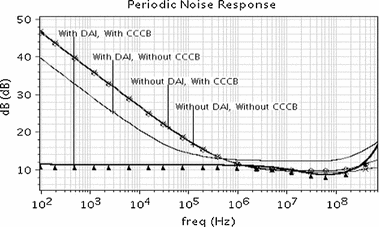

The inversion charge density is thereby resulting in increased drive currents. Metal gates do not suffer from poly-Si gate depletion. Further, metal gates offers many advantages over the poly-Si gates. To alleviate the problems such as poly-silicon (poly-Si) gate depletion, high gate resistance, and dopant penetration from doped poly-Si gate in nanoscale transistors, there is immense interest in the replacement of the conventional poly-Si gate material with metal gate materials. A metal gate material not only eliminates the gate depletion and dopant penetration problems but also greatly reduces the gate sheet resistance. Metal gate technology is particularly attractive because it eliminates the poly-Si gate depletion effect and the associated degradation in transistor performance. Different gate-voltage dependences of 1/f noise above VT are observed, which means that the different charge condition that are near the gate/SiO2 interface induced by different gate electrodes can play an important role in the low-frequency channel current fluctuation. This paper compares the 1/f noise characteristics among the Gate-All-Around Si Nanowire Transistors (GAA SNWTs) with different gate electrodes and the effect of noise spectral density with geometrical parameter of the device are analyzed. According to this model, the input noise is independent of the gate bias, and the magnitude of the noise spectrum is proportional to the density of the interface traps. N-MOS transistor noise power spectral density is predicted by the number fluctuation model.Īn input referred noise voltage increasing with gate bias voltage and proportional to oxide thickness noise is to be the result of fluctuation in carrier mobility, is predicted by the mobility fluctuation model.īased on Correlated carrier and mobility fluctuation models, an unified model is proposed with a functional form resembling the number fluctuation model at low bias and the mobility fluctuation model at high bias. Magnitude of noise spectrum is proportional to the density of oxide traps.
#Flicker noise free
Using the assumption that the necessary time constants are caused by the tunnelling of carriers from the channel into traps located within the oxide.Ĭarrier-density fluctuation models predicting an input referred Noise density independent of the gate bias voltage and proportional to the square of the oxide thickness, the noise can be explained by the fluctuation of channel free electrons by capture and emission of carrier by interface traps (SiO2). Two competing models have been proposed to explain flicker noise: the McWhorter number fluctuation theory and the Hooge mobility fluctuation theory with experimental evidence to support both models. Fluctuations with a 1/f power law have been observed in many electronic materials and devices, including homogenous semiconductors, junction devices, metal films, liquid metals, electrolytic solutions, Josephson junctions, and even in mechanical, biological, geological and even musical systems. Flicker noise is also called 1/f noise, because the noise spectrum varies as 1/fn, where the exponent n is very close to unity. It gets its name from the anomalous plate current “flicker”. Low-frequency or flicker noise first observed in vacuum tubes over eighty years ago dominates the noise spectrum at low frequencies. For these reasons, we focus our work on low frequency noise in Silicon nanowire MOSFETs. In addition, low frequency noise is very sensitive to the technological processes and parameters which are used for IC fabrication. In particular, the lowfrequency noise becomes increasingly important because it can limit the channel spacing in communication systems by being upconverted to phase noise in oscillators and in mixers. However, scaling is accompanied by several complexities, such as the need for more sophisticated device models, increased low-frequency noise (LFN) and the increasing effects due to high electric fields. To improve the performance at increasing operating frequencies, the dimensions especially the channel length and gate insulator thickness in field effect transistors, are now scaled down to the deep submicron range. These demand drives us for low cost, high performance and high functionality development of innovative technologies that is better met by silicon technologies standards.

In many cases, particularly in the consumer field focus is on the towards high volume manufacturing technologies of low cost and low power integrated circuits. Modern analogue and radio frequency (RF) integrated circuits (ICs) are being extensively developed in order to operate at higher frequencies and to satisfy the increasing consumer demand for improved wireless systems with higher functionality.


 0 kommentar(er)
0 kommentar(er)
